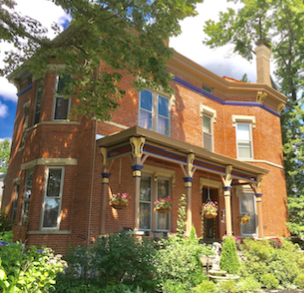By David E. Schroeder
Special to NKyTribune
Sarah Elizabeth Allison Doerr is a name few Northern Kentuckians remember. However, during her life, “Bessie” personally experienced World War I, the Influenza epidemic of 1918-1919, worked in the fields of health care and education, lived abroad, and was one of the pioneers of women holding political office in Northern Kentucky. Bessie Allison Doerr’s life, in many ways, exemplified the twentieth-century experience.
Bessie was born around 1889 to John Allison and Jeanie Buchanan Allison. Both her parents were natives of Scotland. John Allison immigrated to the United States in 1880 and resided for a short period of time in New York City. He then made his way west to Ludlow, Kentucky, where he worked for the Southern Railroad. Around the time of his daughter Bessie’s birth, John began a livery and undertaker business.

As an undertaker, Allison formed partnerships with several area businessmen, the last with the Rose family, resulting in the firm of Allison and Rose, which still exists today. John Allison ran for Kenton County Sheriff in 1913 and held the position from 1914-1918. He was also a founder of the Citizens National Bank in Covington and served as president of the Undertaker’s Association of Kentucky.
John and Jeanie Allison’s daughter, Bessie, graduated from Ludlow High School in 1902 when few women had the benefit of secondary education. Soon after, she was working at the Cincinnati General Hospital as a nurse. Bessie was an adventurous young woman who wanted to make a difference in the world. Here she met a young medical intern by the name of Charles Edward Doerr. Doerr eventually joined the United States Army and became a surgeon stationed at Fort Thomas, Kentucky. On September 29, 1908, Doerr received orders to report to Ft. Myer, Washington D.C. on October 1, 1908 for a new assignment. Not willing to be separated, Charles and Bessie married in the family home on Elm Street in Ludlow on September 30 and travelled to the nation’s capitol that evening.

Charles Doerr eventually served in the Medical Corps in the Philippines. He reached the ranked of Lieutenant Colonel. Bessie travelled with her husband on the adventure to Asia, and here their first child was born in 1912 – a daughter named Allison Doerr.
The United States’ entry into World War I in 1917 resulted in Lt. Colonel Doerr’s assignment as Commander of the army hospital at Camp Humphrey in Washington D.C. Bessie remained home in Ludlow. In September of 1918, influenza began to spread throughout the United States. It was especially prevalent in Washington D.C. where many returning soldiers from Europe were stationed. In one month, the hospital at Camp Humphrey treated 1,800 influenza sufferers. One of those who contracted the disease was Lt. Colonel Doerr, who died on October 3, 1918. He would be among one of the 50 million people who died worldwide in the pandemic. His son, John Charles Doerr, had been born less than a few months before his father’s death.
Lt. Colonel Charles E. Doerr’s body was returned to Ludlow where funeral services were held in the Allison House on Elm Street. He was laid to rest at Highland Cemetery in Ft. Mitchell, Kentucky. Bessie Allison Doerr was left a widow with two small children. Eventually, in the early 1920s, Bessie, her parents, her children and a sister moved into the beautiful old Fleming Home (1878) on Kenner Street in Ludlow. Here she began plans to move on with her life. Bessie decided to carry on the family tradition of public service and became active in the community and in Ludlow Schools.

Bessie Allison Doerr understood that education was the key for her children’s success and those of her neighbors. She became determined that Ludlow would have excellent schools. In 1920, with the passage of the 19th Amendment, American women earned their right to vote. Four years later, Bessie decided to run for a seat on the Ludlow School Board. She became one of the first women in Ludlow and Northern Kentucky to be elected to public office. Not only did she win, but she led the ticket and became the president of the board.
Bessie worked tirelessly on plans to construct a new Ludlow High School to meet the needs of the rapidly growing postwar population. Contracts were accepted for the new 16-classroom, Collegiate Gothic Style structure at the corner of Elm and Adela Streets in June 1931. Bessie addressed the crowd at the cornerstone laying and was full of pride on April 30, 1932 when the building was officially dedicated.
The joy surrounding the new high school was soon dampened by the deaths of her mother and father in 1933. Bessie continued to live in the family home on Kenner Street and remained active at the school and the First Presbyterian Church. She died in the Kenner Street house on September 26, 1970. Bessie was survived by her daughter, Allison Ballantyne, and her son, Dr. John Charles Doerr. She was laid to rest next to her husband in Highland Cemetery – 52 years after his death. A few blocks from the family home still stands Ludlow High School and in the lobby is a bronze plaque bearing the name Bessie Allison Doerr, President, Board of Trustees of Ludlow Schools. It is a fitting memorial to a woman of strength and courage.
David E. Schroeder is Director of the Kenton County Public Library, the author of Life Along the Ohio: A Sesquicentennial History of Ludlow, Kentucky (2014), and coeditor of Gateway City: Covington, Kentucky, 1815-2015 (2015).

























